In an era where digital entrepreneurship shapes the future of earning, the Amazon Affiliate Program emerges as a beacon of opportunity for beginners looking to dive into the affiliate marketing world. This program offers a gateway to monetize website traffic through product endorsements, paving the way for generating income by simply linking to Amazon products. With its vast inventory, Amazon facilitates a wide array of choices and enhances the potential for higher conversion rates, making it a pivotal tool in the affiliate marketing arsenal.
This article will navigate the intricacies of the Amazon Affiliate Program, outlining essential steps from sign-up to earning. It will delve into why this program stands out among other affiliate marketing opportunities, how to become an Amazon affiliate and the process of creating and using affiliate links effectively. Furthermore, it will explore strategies for driving website traffic to these links and offer practical tips for maximizing earnings. By providing a comprehensive guide on utilizing affiliate tools, understanding commission rates, and leveraging social media marketing, readers will be equipped with the knowledge to embark on a successful affiliate marketing journey with Amazon.

What is the Amazon Affiliate Program?
The Amazon Affiliate Program, also known as Amazon Associates, is a cornerstone of affiliate marketing where individuals can monetize their websites, blogs, or social media platforms. This program allows participants to earn commissions by placing links to Amazon products on their platforms. When a customer clicks through these links and makes a purchase, the affiliate earns a referral commission. This model benefits both Amazon and the affiliate: Amazon gains increased traffic and sales, while affiliates earn from qualifying purchases without needing to handle products directly.
Definition and Purpose
Amazon Associates is designed to help content creators, publishers, and bloggers monetize their traffic. By using simple link-building tools, affiliates direct their audience to products and earn from purchases and certain programs. The primary purpose of this program is to expand Amazon’s reach and increase sales through a cost-effective marketing strategy. Affiliates benefit by engaging in e-commerce with minimal overhead, as they do not need to maintain an inventory or manage orders.
Eligibility Criteria
To participate in the Amazon Affiliate Program, applicants must meet specific criteria to ensure they add value to Amazon’s customer base. Potential affiliates need to have a platform, such as a website, blog, or social media account, with a substantial following and quality content. For websites and blogs, Amazon requires ownership by the applicant, a minimum of 10 original posts, and recent activity within the last 60 days. Social media accounts must be public and active, with a significant number of organic followers.
For mobile apps and Alexa skills, compliance with Amazon’s Mobile Application Policy and Alexa Skill Certification requirements is mandatory. Moreover, all platforms must adhere to Amazon’s guidelines, which include prohibitions on promoting inappropriate content and the use of Amazon-trademarked materials without permission.
Applicants must also disclose their affiliate status to comply with Federal Trade Commission regulations, ensuring transparency with their audience. This disclosure is crucial for building trust and maintaining the integrity of the affiliate’s platform.
By fulfilling these conditions, individuals can leverage their digital presence to generate income through the Amazon Affiliate Program, enhancing their content with monetized product links and contributing to Amazon’s extensive product ecosystem.
Why Choose the Amazon Affiliate Program?
Benefits and Advantages
The Amazon Affiliate Program, known for its robust conversion rates and extensive product range, stands out as an exemplary choice for affiliate marketers. Despite not offering the highest commission rates, Amazon’s conversion rates are notably superior, with recorded conversions at an impressive 15.19% in 2022, significantly outperforming other programs like Avantlink and Skimlinks, which showed conversion rates of only 0.89% and 1.09% respectively. This high conversion rate means that even with lower commission percentages, the earnings potential from Amazon can be equivalent to or better than other programs offering higher rates.
Amazon’s global presence and vast product inventory cater to a wide audience, ensuring that affiliates can find products relevant to their niche. Additionally, the program’s structure allows for earnings from not just the products directly linked but also from other items added to the cart by customers during the same session, enhancing the potential for increased commissions.
The trust and recognition associated with the Amazon brand also play a crucial role in the program’s appeal. Consumers are more likely to purchase from a well-known and trusted platform, and Amazon’s consistent efforts to maintain customer satisfaction through reliable service and product quality contribute to higher conversion rates.
Furthermore, Amazon offers various tools and reports that help affiliates track their performance and optimize their strategies. These resources are invaluable for affiliates aiming to maximize their earnings and understand their audience better.
Examples of Success
Many successful affiliate websites exemplify the potential of the Amazon Affiliate Program. For instance, niche sites focusing on outdoor gear have leveraged Amazon’s diverse product range to create comprehensive product round-ups that attract significant traffic and sales. These sites benefit not only from direct product recommendations but also from incidental purchases made by visitors browsing other related products.
Another example is GearLab, which has effectively turned its affiliate disclosure into a branding opportunity. By transparently communicating its affiliate relationship with Amazon, GearLab enhances its credibility and trust with its audience, which is essential for maintaining a loyal following and driving consistent affiliate revenue.
Moreover, the Amazon Affiliate Program contributes significantly to the incomes of various affiliate marketers. For some, Amazon’s affiliate earnings comprise a substantial portion of their total income, underscoring the program’s effectiveness as a revenue-generating tool. Even with what some might consider lower commission rates, the ease of use and broad customer base make Amazon a preferred choice for many affiliates.
In conclusion, the Amazon Affiliate Program offers a multitude of benefits that make it an attractive option for both new and experienced affiliates. Its high conversion rates, extensive product selection, and the trust associated with the Amazon brand are just a few of the reasons why it remains a top choice in the world of affiliate marketing.
How to Sign Up for the Amazon Affiliate Program
Step-by-Step Signup Process

- Create a Website or Blog: Before one can apply to the Amazon Affiliate Program, one must have an active website, blog, or social media platform that does not violate intellectual property rights or promote inappropriate content. Read more about create a free website using blogger.
- Navigate to the Amazon Associates Homepage: Individuals should start by visiting the Amazon Associates homepage and clicking on the ‘Sign Up’ button to initiate the registration process.
- Fill Out the Online Registration Form: Applicants are required to fill out a brief online registration form to gain access to Associates Central, where they can begin linking to Amazon products.
- Enter Account Information: During the signup process, applicants must provide complete and accurate personal details, including their email address and other contact information. This information must be kept up-to-date to receive important notifications related to the Associates Program.
Providing Personal Details and Website Information
- Enter Your Website Address: Applicants need to enter the URL of their website, blog, or social media account. This site must contain original content and be publicly available.
- Add Your Preferred Associate ID: During the registration, applicants must choose a store ID that typically represents their business or the content theme of their website.
- Describe Traffic and Monetization Methods: It’s crucial to explain how traffic is driven to the site. Applicants should detail the methods used for website monetization and traffic generation.
- Choose Your Payment Method: Applicants must select a preferred payment method for receiving commissions from the Amazon Affiliate Program. This step is essential to ensure that earnings are properly processed and disbursed.
- Verify Your Account Identity: To complete the signup process, applicants must verify their account identity by providing the necessary documentation. This step is crucial to ensure the authenticity of the information provided and compliance with the program’s requirements.
By following these steps meticulously, individuals can successfully sign up for the Amazon Affiliate Program and start monetizing their online presence through affiliate marketing.
Building Your Profile and Setting Up Your Store ID
To effectively participate in the Amazon Affiliate Program, setting up a unique store ID and meticulously building your profile are crucial steps. Here’s a detailed guide on how to navigate this process.
Choosing Your Store ID
When joining the Amazon Affiliate Program, one will receive a unique preferred associates store ID. This ID is crucial as it tracks your referrals and earnings. Amazon adds a unique number at the end of your preferred ID to ensure distinctiveness among users. For instance, if one is based in the US, the store ID will end with ‘-20’, while in India, it will end with ‘-21’. It’s imperative to use this ID correctly in your affiliate links as it directly affects your affiliate income.
Here are the steps to create and set up your store ID:
- Create an Amazon Account: Ensure you have an active Amazon account. If not, create one to proceed.
- Join the Amazon Associates Program: Use your Amazon account credentials to join the program.
- Account Information Review: In the next window, review all your account information. Ensure the details are correct and click on the ‘Next’ option.
- Add Websites and Apps: Add all the top-level websites and apps where you intend to display the affiliate links. These platforms must be fully developed as they will be thoroughly reviewed.
- Choose Your Store ID: Use a memorable name related to your website for easy recall. For example, if your website is named ‘MyExampleSite’, your store ID would be ‘MyExampleSite-20’ in the US.
Describing Your Website’s Purpose and Audience
It is essential to clearly articulate the purpose of your website and the target audience to align with the Amazon Affiliate Program’s standards. This description not only helps Amazon assess the suitability of your site for their program but also ensures that the affiliate links placed are relevant and effectively targeted.
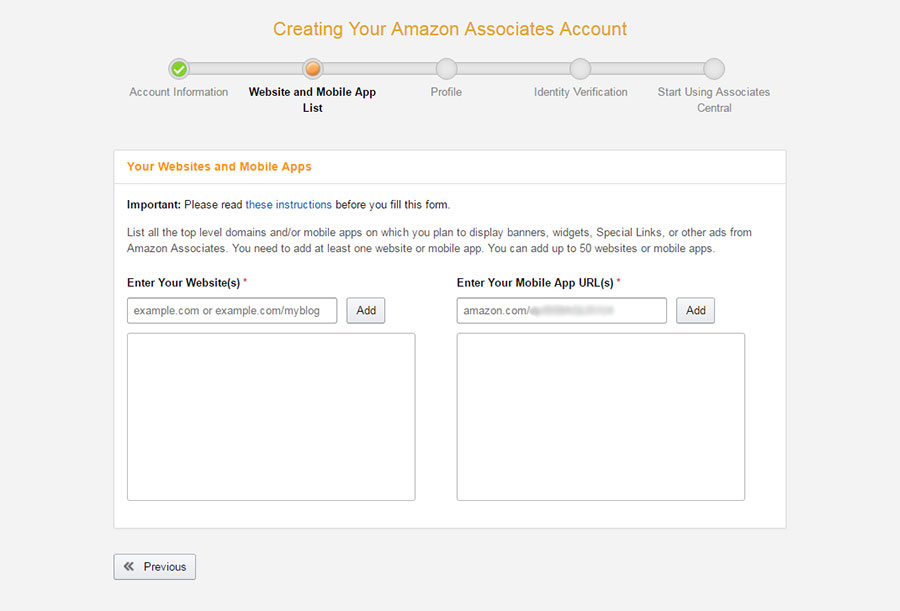
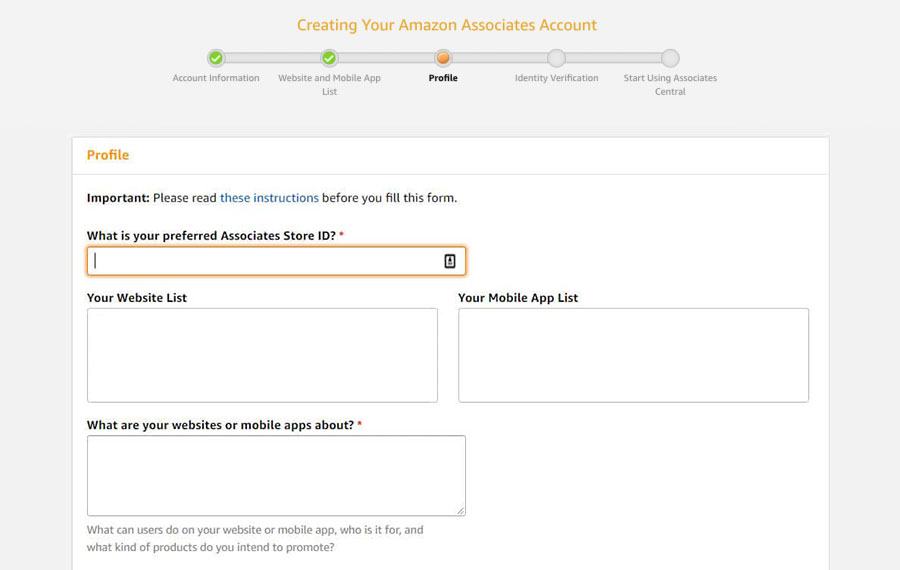
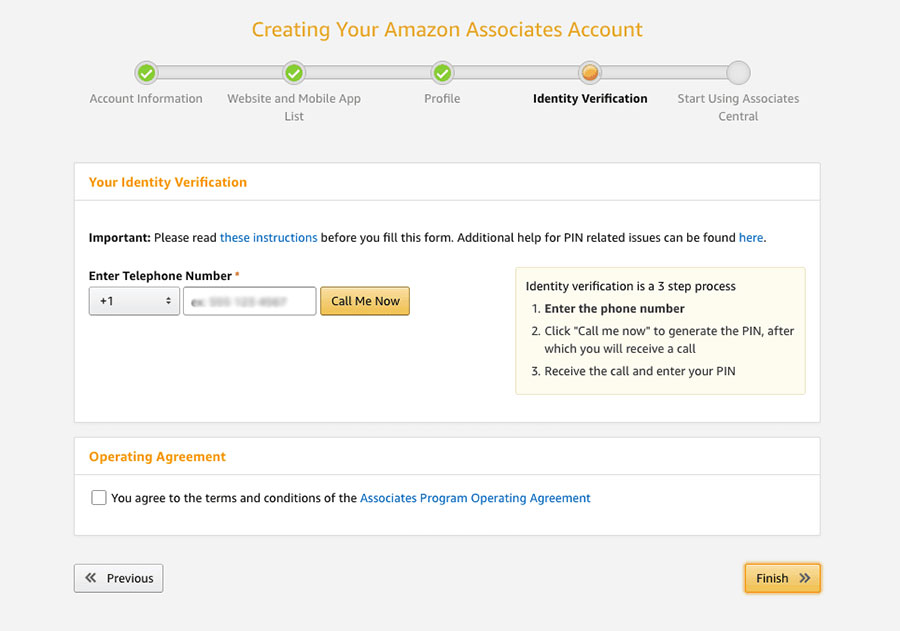
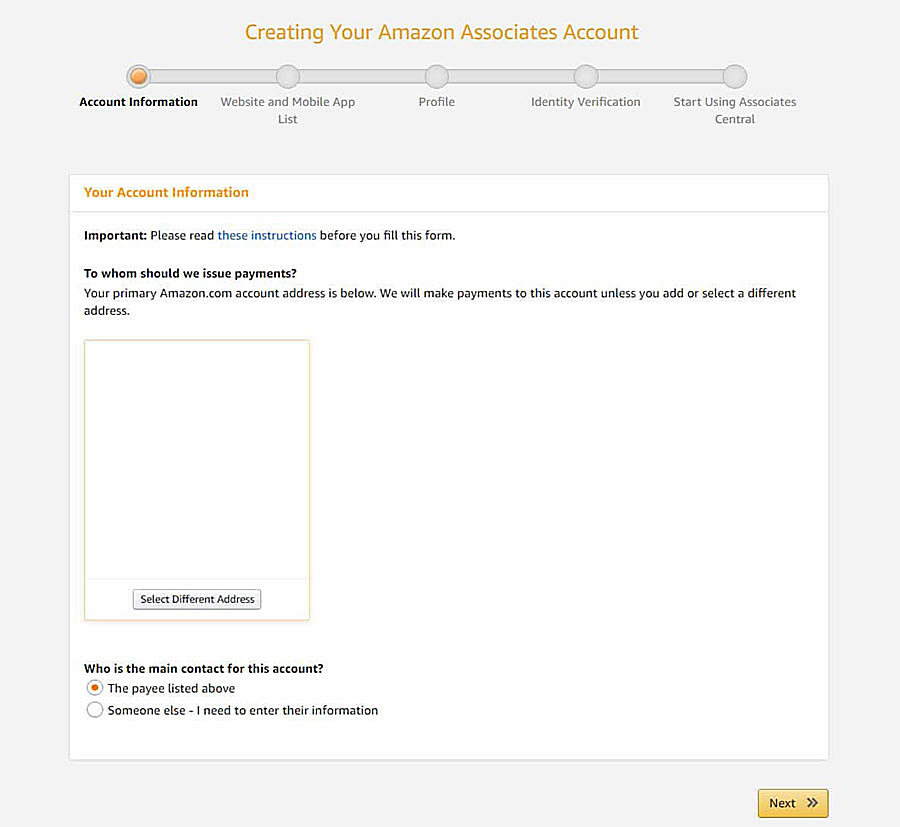
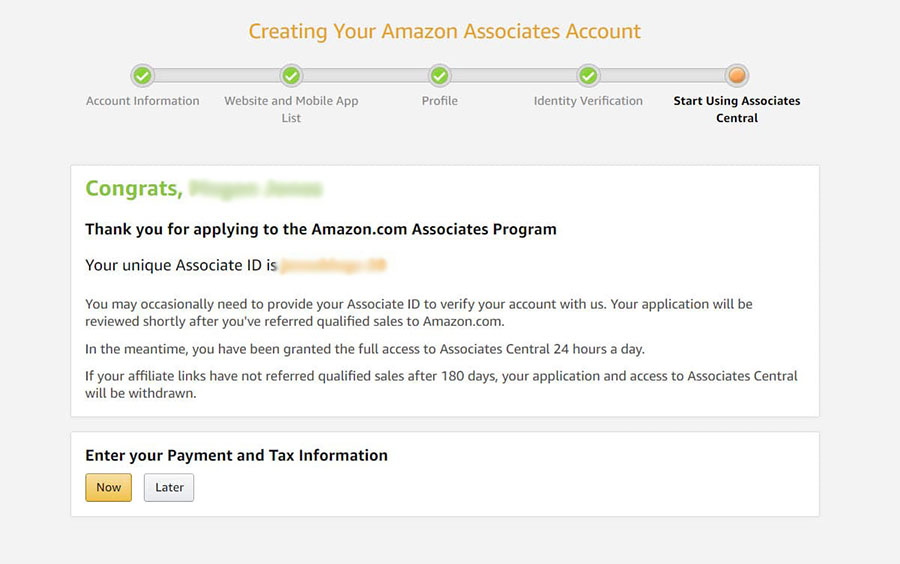
When setting up your profile, consider the following:
- Website Purpose: Explain the core focus and objective of your website. For instance, if your site is dedicated to tech gadgets, outline how it provides valuable information or reviews on the latest technology.
- Target Audience: Describe who your content is intended for. Understanding your audience’s preferences and needs can help tailor your affiliate marketing strategies effectively.
By comprehensively setting up your store ID and accurately describing your website’s purpose and audience, you enhance your credibility and operational efficiency in the Amazon Affiliate Program. This preparation not only streamlines your affiliate activities but also maximizes the potential for earning commissions through targeted and relevant affiliate links.
Creating and Using Amazon Affiliate Links
Using the Amazon SiteStripe Tool
The Amazon SiteStripe tool offers a streamlined approach for affiliates to create and manage their affiliate links directly from the Amazon website. Once an affiliate is logged into their Amazon Associates account, the SiteStripe bar appears at the top of every page on Amazon. This feature allows affiliates to quickly generate links for any product or page they wish to promote. By navigating to the ‘Tools’ section and selecting ‘SiteStripe’, users can enable this feature and start building links right from the Amazon page itself.
SiteStripe simplifies the link creation process by automatically including the affiliate’s store ID in the generated links. This ensures that all referrals are correctly attributed to the affiliate’s account, securing their commissions for any purchases made through these links. Additionally, the tool provides options to share generated links on social media platforms like Facebook and Twitter, enhancing the affiliate’s ability to reach a broader audience.
Generating Text and Image Links
Affiliates can choose between different types of links depending on their content strategy. The SiteStripe tool allows for the creation of text, image, or combined text and image links. For instance, if an affiliate wants to promote the Amazon Echo Dot, they can select the appropriate option to generate a link that includes either text, an image, or both. These links can then be easily integrated into website content, blog posts, or social media updates.
When generating links, it is crucial for affiliates to ensure they are using the correct store and tracking ID, especially if they have set up multiple options. Once the desired link type is selected, the affiliate simply copies and paste the generated link into their site. This process not only facilitates the promotion of specific products but also allows affiliates to direct their audience to general pages, such as a category page for Fire Sticks, giving the audience the freedom to choose from various products.
For affiliates focusing on specific products, the SiteStripe tool enables them to create direct links to product detail pages. This can be particularly useful when recommending a specific item, such as a particular model of the Fire Stick. Affiliates can generate a text link or opt for an image link, which can be added to a blog post or website using the provided HTML code. By using these targeted links, affiliates can effectively guide their audience to the products they recommend, potentially increasing the likelihood of purchases and earning commissions on a wider range of products purchased within 24 hours of clicking the affiliate link.
By leveraging the SiteStripe tool and its various linking options, affiliates can enhance their marketing strategies, tailor their promotional efforts to their audience’s preferences, and maximize their earning potential through the Amazon Affiliate Program.
Driving Traffic to Your Affiliate Links
SEO Strategies
To effectively drive traffic to your Amazon affiliate links, implementing robust SEO strategies is crucial. One of the foundational elements of SEO is producing high-quality content that resonates with both users and search engines. Additionally, optimizing images by naming the file with relevant keywords and reducing their size can significantly enhance page loading speeds and improve SEO performance.
Keyword research is paramount in aligning your content with user searches. Utilizing tools like Google’s Keyword Planner for beginners, or Ahrefs and SEMRush for those with a budget, helps in identifying valuable keywords to target. Moreover, placing these keywords strategically in SEO titles, meta descriptions, and throughout the content can boost visibility and click-through rates.
The structure and internal linking within your site also play a vital role. By linking to other relevant posts within your site, you not only improve SEO but also enhance user engagement and reduce bounce rates. Furthermore, securing backlinks from reputable sites within the same industry can elevate your site’s authority and rankings.
Social Media Promotion
Leveraging social media platforms is another effective strategy to drive traffic to your Amazon affiliate links. Platforms like Facebook, YouTube, Twitter, and Instagram offer vast potential for reaching diverse audiences. Sharing your affiliate links on these platforms, while ensuring compliance with Amazon’s guidelines, can increase visibility and drive traffic effectively.
It is essential to maintain transparency when sharing affiliate links on social media. Including a mention of “Amazon” near the link or in the call to action can build trust with your audience. Additionally, adhering to the Federal Trade Commission’s requirements by disclosing the affiliate relationship using terms like “#ad” or “#CommissionsEarned” is crucial for compliance and maintaining credibility.

Organizing affiliate links through tools like Choice Pages can also streamline the process, making it easier for affiliates to manage their links across different platforms and ensure compliance with Amazon’s policies. This organization aids in presenting a clear and professional approach to affiliate marketing on social media, enhancing user trust and potentially boosting conversion rates.
By implementing these SEO and social media strategies, affiliates can significantly enhance their ability to drive traffic to their Amazon affiliate links, increasing the potential for earning commissions and achieving success in the Amazon Affiliate Program.
Tips for Boosting Earnings from Amazon Affiliate Program
Choosing a Niche
Selecting the right niche is foundational for success in the Amazon Affiliate Program. A niche should be a specialized subset of a larger market that catifies unique needs, preferences, or identities. This specialization often leads to higher levels of customer engagement and loyalty, crucial for affiliate marketing success.
When choosing a niche, it is essential to consider factors such as market demand and growth potential. Tools like Google Trends and Amazon Best Sellers provide insights into what products are trending and can help identify high-demand areas. Additionally, understanding the competition level using tools like SEMrush or Ahrefs can provide a clear picture of what one is up against and help in strategizing accordingly.
Moreover, it’s beneficial to select a niche with a variety of high-quality products. This not only helps in attracting a broad audience but also mitigates risks associated with product availability and consumer preference shifts. Understanding audience demographics and psychographics is also crucial as it allows for tailored content that resonates with the potential buyers’ needs and drives conversions.
Writing Product Reviews and Comparisons
Product reviews and comparisons are potent tools in an affiliate marketer’s arsenal, significantly influencing buyer decisions. To write effective product reviews, one must conduct thorough research to understand the product features, benefits, and user perceptions. This depth of knowledge allows for crafting detailed and informative reviews that can guide potential buyers.
Maintaining honesty and integrity in reviews is vital. A balanced view that highlights both positives and negatives of a product helps build trust with the audience. It’s also important to discuss the benefits of the product, focusing on how it solves problems or improves the user’s life.
Writing in a conversational tone can make the reviews more relatable and engaging. Incorporating personal experiences with the product adds authenticity and can enhance the persuasive power of the review. Organizing the review in a clear, logical structure with visual elements like images or videos can further enhance its appeal and effectiveness.
Finally, optimizing product reviews for search engines by including relevant keywords can increase visibility and drive more traffic to the affiliate links. Incorporating social proof, such as customer testimonials and ratings, can also play a crucial role in reinforcing the credibility of the reviews and encouraging purchases.
By carefully selecting a niche and crafting compelling product reviews, Amazon affiliates can enhance their site’s appeal and effectiveness, leading to increased traffic and higher conversion rates, thereby boosting their earnings from the program.
Conclusion
Through this comprehensive journey, we’ve explored the potent opportunities that the Amazon Affiliate Program offers to both budding and seasoned digital entrepreneurs. The program’s accessibility, combined with Amazon’s vast product selections and trusted brand recognition, paints a vivid picture of potential success. Emphasizing key strategies for signing up, generating, and driving traffic to affiliate links, we encapsulated the essence of leveraging digital platforms to convert viewership into a steady income stream. More importantly, we underscored the significance of choosing an appropriate niche and the impact of SEO and social media promotion in magnifying outreach and hence, profitability.
Embarking on an affiliate marketing venture with Amazon not only paves the way for financial gain but also cultivates an intricate understanding of digital marketing dynamics. As readers pursue or enhance their affiliate marketing endeavors, they are equipped with the knowledge to navigate the intricacies of affiliate marketing efficiently. The insights shared here serve as a beacon, guiding towards informed decisions and strategic alignments that amplify the chances of success in the digital marketplace. Keeping the reader informed in an easy-to-read manner and maintaining a consistent tone were central to our discussion, aiming to ensure that the content is not only accessible but also engaging from start to finish.
FAQs
A beginner in the Amazon Affiliate program can expect to earn anywhere from $100 to $20,000. Earnings vary widely based on the number of referrals generated. The program pays commissions based on sales made through affiliate links.
To earn affiliate income from Amazon, start by creating an Amazon Affiliate link. On the Amazon Associates homepage, navigate to ‘Product Linking’ then ‘Product Links’. Perform a keyword search for the product you wish to promote or input a specific ASIN. After finding the product, click ‘Get Link’ and select your preferred link type. Finally, embed this link on your website or any platform where you promote Amazon products.
The first step in starting Amazon affiliate marketing is to set up your Amazon Associates account. Visit the Amazon Associates homepage and click on ‘Sign Up’. You will be directed to log in using your existing Amazon account, or to create a new one if necessary.
Getting approved for the Amazon Affiliate program is relatively straightforward. The key requirement is to have a suitable platform, such as a website, a YouTube channel, or a mobile app, where you can showcase and discuss Amazon products. This platform serves as the common ground between you and your audience.
Truely helpful